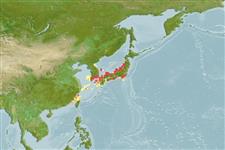Environment / Climate / Range
Ecology
Marine; brackish; demersal. Subtropical, preferred ?; 48°N - 20°N
Northwest Pacific: southern Siberia to Taiwan (Ref. 244). Nominal records from the Philippines (Ref. 13563).
Length at first maturity / Size / Weight / Age
Maturity: Lm ?, range 99 - 108 cm
Max length : 150 cm TL male/unsexed; (Ref. 244)
Found on the continental and insular shelves, often occurring in shallow water close inshore. Prefers estuaries and shallow bays, especially sandy and algal-covered areas and eelgrass flats. Feeds on small fishes and probably crustaceans and other benthic invertebrates. Often solitary, though some may cluster in resting areas on bottom. Ovoviviparous (aplacental), with 10 to 20 young in a litter. Meat is regarded as of inferior quality.
Ovoviviparous, embryos feed solely on yolk (Ref. 50449).
Compagno, L.J.V., 1984. FAO Species Catalogue. Vol. 4. Sharks of the world. An annotated and illustrated catalogue of shark species known to date. Part 2 - Carcharhiniformes. FAO Fish. Synop. 125(4/2):251-655. Rome: FAO. (Ref. 244)
IUCN Red List Status (Ref. 115185)
CITES (Ref. 94142)
Not Evaluated
Human uses
Fisheries: minor commercial
More information
ReferencesAquacultureAquaculture profileStrainsGeneticsAllele frequenciesHeritabilityDiseasesProcessingMass conversion
Tools
Special reports
Download XML
Internet sources
Estimates of some properties based on models
Phylogenetic diversity index (Ref.
82805): PD
50 = 0.5312 [Uniqueness, from 0.5 = low to 2.0 = high].
Trophic Level (Ref.
69278): 3.8 ±0.2 se; Based on diet studies.
Resilience (Ref.
69278): Low, minimum population doubling time 4.5 - 14 years (Fec=10).
Prior r = 0.13, 2 SD range = 0.02 - 0.76, log(r) = -2.04, SD log(r) = 0.88, Based on: 1 K, 1 tmax, 2 Fec records
Vulnerability (Ref.
59153): High to very high vulnerability (67 of 100) .
